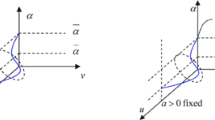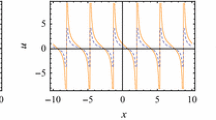Abstract
We study the large time behavior of a class of diffusive predator–prey systems posed on the whole Euclidean space. By studying a family of similar problems with all possible spatial translations, we first prove the asymptotic persistence of the prey for the spatially heterogeneous case under certain assumptions on the coefficients. Then, applying this persistence theorem, we prove the convergence of the solution to the unique positive equilibrium for the spatially homogeneous case, under certain restrictions on the space dimension and the predation coefficient.
Similar content being viewed by others
References
S. Agmon, On positivity and decay of solutions of second order elliptic equations on Riemannian manifolds. Methods of functional analysis and theory of elliptic equations (Naples, 1982), 19–52. Liguori, Naples, 1983.
D.G. Aronson, H.F. Weinberger, Nonlinear diffusion in population genetics, combustion, and nerve pulse propagation, in: J.A. Goldstein(Ed.), Partial Differential Equations and Related Topics, in: Lecture Notes in Math., vol. 446, Springer, Berlin, 1975, 5–49.
D. G. Aronson, H. F. Weinberger, Multidimensional nonlinear diffusions arising in population genetics, Adv. Math., 30 (1978), 33–76.
H. Berestycki, L. Nirenberg and S.R.S. Varadhan, The principle eigenvalue and Maximum principle for second-order elliptic operators in general domains, Comm. Pure Appl. Math., 47 (1994), 47–92.
H. Berestycki and L. Rossi, Generalizations and Properties of the Principal Eigenvalue of Elliptic Operators in Unbounded Domains, Comm. Pure Appl. Math., 68 (2015), 1014–1065.
Y. Du and S.-B. Hsu, A diffusive predator-prey model in heterogeneous environment, J. Diff. Equations, 203 (2004), 331–364.
A. Ducrot, Convergence to generalized transition waves for some Holling-Tanner prey- predator reaction-diffusion system, J. math. pures appl., 100 (2013), 1–15.
L. C. Evans (1998), Partial differential equations. American Mathematical Society, USA. For elliptic PDEs see Theorem 5, p. 334 and for parabolic PDEs see Theorem 10, p. 370.
J. K. Hale and P. Waltman, Persistence in infinite dimensional systems, SIAM J. Math. Anal., 20 (1989), 388–395.
S.-B. Hsu and T.-W. Huang, Global stability for a class of predator-prey systems, SIAM J. Appl. Math., 55 (1995), 763–783.
P. Magal and X.-Q. Zhao, Global attractors and steady states for uniformly persistent dynamical systems, SIAM J. Math. Anal., 37 (2005), 251–275.
J. Moser, A Harnack inequality for parabolic differential equations, Communications on Pure and Applied Mathematics 17 (1964), 101–134.
J.D. Murray, Mathematical Biology, Springer, Berlin, 1993.
E. Renshaw, Modelling Biological Populations in Space and Time, Cambridge University Press, Cambridge, 1991.
J. Simon, Compact sets in the space \(L^p(0,T;B)\), Ann. Math. Pura Appl., 1 (1987), 65–96.
H. L. Smith and H. R. Thieme, Dynamical systems and population persistence, American Mathematical Soc., 2011.
Author information
Authors and Affiliations
Corresponding author
Additional information
J.-S. Guo is partially supported by the Ministry of Science and Technology of Taiwan under the Grant 102-2115-M-032-003-MY3. Part of this work was carried out during a visit of the A. Ducrot to Tamkang University. We would like to thank the support of the National Center for Theoretic Sciences for his visit.
Rights and permissions
About this article
Cite this article
Ducrot, A., Guo, JS. Asymptotic behavior of solutions to a class of diffusive predator–prey systems. J. Evol. Equ. 18, 755–775 (2018). https://doi.org/10.1007/s00028-017-0418-y
Published:
Issue Date:
DOI: https://doi.org/10.1007/s00028-017-0418-y




